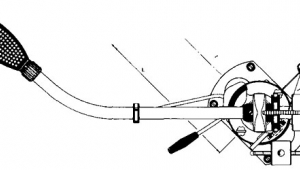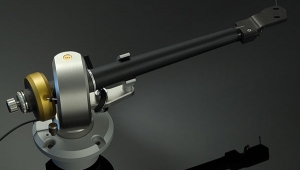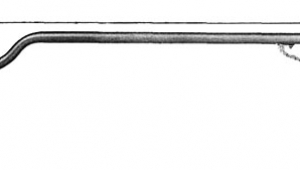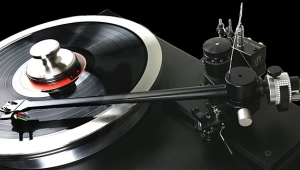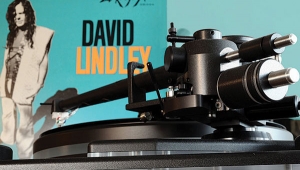| Columns Retired Columns & Blogs |
Linn Ekos tonearm Alvin Gold Comments
Sidebar 2: Alvin Gold Comments
Alvin Gold commented on the Ekos in March 1989 (Vol.12 No.3):
The heavyweight arm introduction of the year, of course, is the Linn Ekos. Visually almost identical to the Ittok, it is a triumph of the artisan, being essentially bankrupt of new thinking, especially when measured against the Roksan Artimez. Instead, it could be seen as the triumph of evolution over revolution. But it is a triumph.
The arm is not the same as the Ittok because almost all the components are different. I think only the bias force dial—incidentally, the only item now made in Japan—is carried over from the old model. The differences extend to the materials, interfaces, and manufacturing processes involved, but other than that the two arms look pretty similar. The Ekos has a black finish, while the Ittok is covered in bright metal, au naturel as it were. Paradoxically it looks much more expensive that way. There have even been black Ittoks, which must be almost totally indistinguishable from the Ekos. In such cases you'll have to look at the armrest. The Ekos armrest is built into the base structure, bringing the arm into line with virtually all other arms and thus simplifying installation.
Armrest apart, the differences between the two Linn arms are small but vital, in engineering terms and in performance. But these differences make the arm considerably more expensive. The armtube, of a new and harder alloy, instead of being screwed and glued at each end, is secured by just a high-tech glue, a much more elegant solution that avoids deforming and stressing the components. Linn claims this join is functionally identical to a one-piece armtube. Who am I to argue?
The armtube and headshell are made from new ultra-hard alloys, and the bearing housing is machined from solid instead of being cast è la Ittok, which enables a much harder alloy to be used. A similar story applies at the headshell end. The bearings are made to 1µm tolerances. Linn says that this is as good as can be achieved in practice, and even then only by selection since 4µm is the best that can be ensured for individual machining operations.
I confess (without prejudice) that I was startled to discover that this is precisely the tolerance level Rega claims to achieve routinely with their £90 arm, the RB300 (incidentally, the component Rega claims is their most profitable). Rega also says they could make the Ekos cheaper than they could make the Ittok, but they don't, and words are cheap, n'est-ce pas?
What else has Linn done? They've changed the output plug, which is metal and reshaped for strength, an apparently minor change that Linn says had a surprisingly large audible effect. The cable can be retrofitted to other Linn arms too, but note that the wiring (as opposed to the plug) remains identical. Finally, arm cueing is damped in both directions to reduce resonances from this source. This makes it a pig to handle when lifting the arm from a suspended turntable, but practice makes perfect. Or not, depending.
The new Linn arm is expensive, but if justification can be provided by the way the arm behaves, then there can be no complaints. I confess to finding the price—a little over twice that of the Ittok—hard to swallow unless Linn really intends making the arm in very small quantities. Rightly or wrongly, I perceive the SME Series V as a lot more expensive to build, even if it doesn't necessarily show any resulting musical advantage. When questioned on these matters, Linn pointed out that on a scale of hardness known as the ABEX scale, their bearing rated 7 against 5 for the SME V, and 0 (would you believe) for the Ittok, But I don't know if this means anything except that they're interested in what SME is doing. That's significant, I suppose.
Summarizing, the Ekos is all about building an Ittok-like arm much, much stronger, but offering all the old advantages including the practicality and lack of temperament for which the Ittok was justly renowned. The Ekos also has the third mounting hole demanded by the Troika, and it was with that cartridge, and both Linn and Pink Triangle turntables, that I did most of my listening.
The new arm successfully addresses just those areas where the Ittok was at its weakest, and make no mistake: it is a very impressive machine. The most striking advances apparent in the new arm are much more consistent and explicit stereo imagery, and a sweeter, more lucid presentation. Consistency is at the root of these things, and ties in with what can best be described as an "on rails" quality when playing music, which had much of the poise and strength exemplified by the Airtangent, though the two are hardly comparable in any other respect.
Except this one: The Ekos is capable of one rather remarkable feat that is bettered by very few arms, of which the Airtangent is perhaps preeminent. It reproduces a coherent and believable soundstage right down into the darkest recesses of the bass. By contrast, the Ittok foundered here, with stereo images largely mono'd at the lowest frequencies. The Ekos was, in any case, sharper and leaner through the bass, which made it sometimes less obvious, but considerably meaner and more potent when something came along to stir it into life. It excelled on orchestral bass and cellos and—most strikingly of all—the soft ambient cues that define an acoustic space. It's easy to see where the stereo ability springs from.
The Ittok is also a mite coarse by the finest standards, and here, too, the Ekos shows considerably greater capabilities. Though less obvious than the Ittok, it has greater subtlety and range, a greater ability to show light and dark, piano and forte. The Ekos follows the music better and imposes less of itself in the process. In short, it is one of the finest arms available, a comment especially true of pivoted arms. This is one Linn product of which I have no complaints, other than that it isn't cheap enough that everyone could have one.—Alvin Gold
- Log in or register to post comments


